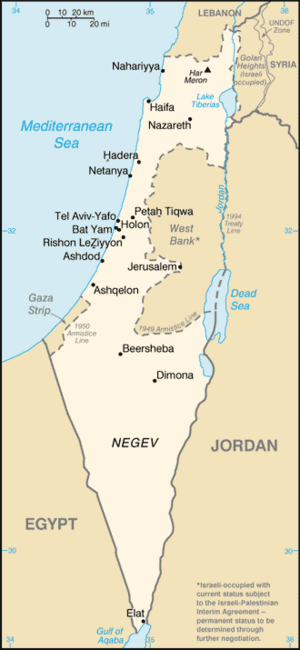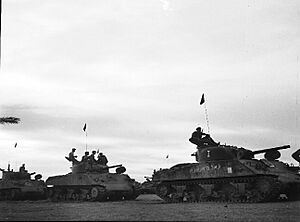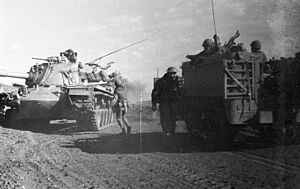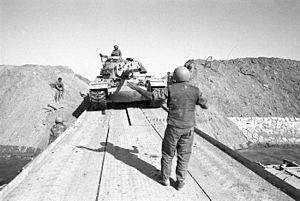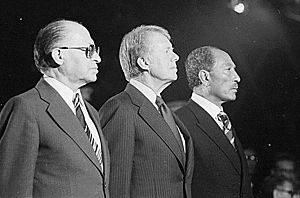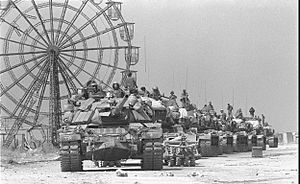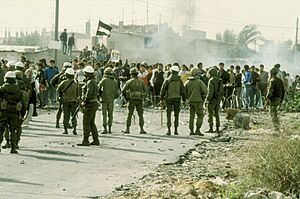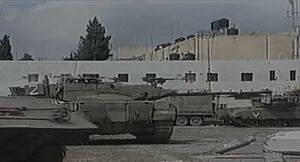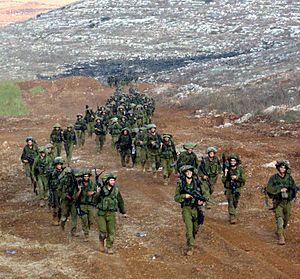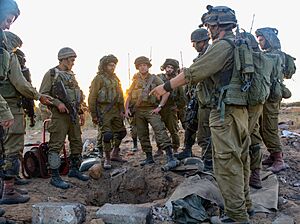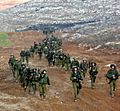History of Israel (1948–present) facts for kids
In 1948, after a civil war in the land known as Mandatory Palestine, the Declaration of the Establishment of the State of Israel was announced. This led to the 1948 Arab–Israeli War. Many Palestinians left their homes, and many Jewish people from other parts of the Middle East moved to Israel.
The second half of the 20th century saw more conflicts between Israel and its Arab neighbors. In 1967, the Six-Day War happened. After this war, Israel took control of the Golan Heights from Syria, the West Bank from Jordan, and the Gaza Strip and Sinai Peninsula from Egypt. In 1973, the Yom Kippur War began with an attack by Egypt on the Sinai Peninsula.
In 1979, Israel and Egypt signed a peace treaty, based on the Camp David Accords. In 1993, Israel signed the Oslo I Accord with the Palestine Liberation Organization (PLO). This led to the creation of the Palestinian National Authority. In 1994, Israel and Jordan signed a peace treaty. Even with these efforts, the conflict continues to be a big part of life in Israel and around the world.
Contents
Israel's Independence Day
The British were scheduled to leave Palestine on May 15, 1948. The Jewish community's leaders, the Jewish National Council, began planning for a Jewish government. On May 14, 1948, the last British forces left.
The People's Council gathered at the Tel Aviv Museum. They declared the creation of a Jewish state in Eretz Israel, to be called the State of Israel. This new state was meant to be a home for Jewish people. David Ben-Gurion, a key leader, led the event. He soon became Israel's first Prime Minister.
Israel celebrates this day every year as Independence Day. It is a national holiday on the 5th of Iyar in the Hebrew calendar. The Declaration stated that Israel would be based on freedom, justice, and peace. It promised equal rights for all its people, no matter their religion, race, or gender.
The First Arab–Israeli War
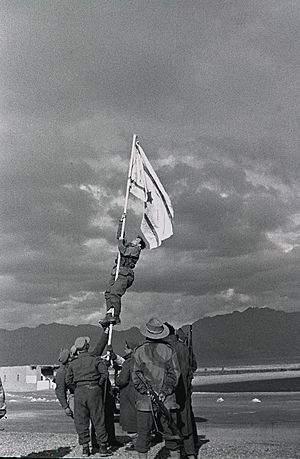
Right after Israel declared its independence, the United States and the Soviet Union recognized the new state. However, Arab League countries like Egypt, Jordan, Syria, Lebanon, and Iraq did not accept the UN plan to divide Palestine. They sent their armies into the former British Mandate. This started the first Arab–Israeli War.
The Arab states had strong military equipment. The Jewish forces, not yet a state, could not buy heavy weapons at first. On May 29, 1948, the British started an arms ban on the region. But Czechoslovakia helped Israel by sending important military supplies. This helped Israel match the equipment of the Arab armies. A month-long UN truce began on June 11.
After independence, the Haganah, a Jewish defense group, became the Israel Defense Forces (IDF). Other Jewish fighting groups were asked to join the IDF. Many Jewish immigrants arrived in Israel, including World War II veterans and Holocaust survivors. Many of them joined the IDF.
At first, the Arab armies gained some land. But from July, the Israelis began to push back. They pushed the Arab armies out and took control of some areas that were meant for the Arab state. By the end of November, ceasefires were arranged.
Peace Agreements and New Borders
Israel signed agreements with Egypt (February 24), Lebanon (March 23), Jordan (April 3), and Syria (July 20). These were armistices, not full peace treaties. With the fighting stopped, Israel's new borders, known as the Green Line, were set. Arab states did not recognize these as international borders.
Israel controlled the Galilee, Jezreel Valley, West Jerusalem, the coastal plain, and the Negev. Jordan kept the West Bank, and Egypt held the Gaza Strip.
After the ceasefire, Britain released Jewish people held in Cyprus and recognized Israel. On May 11, 1949, Israel became a member of the United Nations. About 6,000 Israelis, including 4,000 soldiers, died in the war.
Palestinian Refugees
According to the United Nations, about 726,000 Palestinians left or were forced from their homes between 1947 and 1949. Many settled in Palestinian refugee camps in nearby countries. About 80% of the Arab people in what became Israel left their homes. Later, Israeli laws prevented them from returning or claiming their property. They and their families remain refugees.
Except in Jordan, Palestinian refugees often lived in crowded camps. They were not given citizenship by their host countries. In December 1949, the UN created an agency (UNRWA) to help Palestinian refugees.
Education and Culture
In 1949, education became free and required for all citizens up to age 14. The government funded different education systems. A separate system was created for the Palestinian-Arab population. In the early 1950s, there were efforts to help new immigrants adjust.
The Technion, a famous Israeli university, worked to bring scientists to Israel. They wanted to build research labs and teaching departments in science.
Early Hebrew literature in Israel was written by authors from Europe. Yosef Haim Brenner and Shmuel Yosef Agnon are seen as fathers of modern Hebrew literature. Writers born in Israel, often called the "War of Independence generation," brought a unique Israeli style to their writing.
International Relations
In its early years, Israel tried to stay neutral between the major world powers. But after some events, like trials against Jewish doctors in the Soviet Union, Israel stopped trying to be neutral. Egypt closed the Suez Canal to Israeli ships in 1950. In 1952, Gamal Abdel Nasser came to power in Egypt.
The United States became close with new Arab states, especially Egypt. Israel then built good relationships with newly independent countries in Africa and with France. France was involved in a war in Algeria at the time.
Mid-1950s to Early 1960s
Suez Crisis (1956)
In 1955, Egypt made a large arms deal with Czechoslovakia. This changed the balance of power in the Middle East. In 1956, Egyptian President Nasser took control of the Suez Canal. This canal was Egypt's main source of foreign money. Egypt also blocked the Gulf of Aqaba, stopping Israeli ships from reaching the Red Sea.
Israel made a secret agreement with France to work together against Egypt. Britain and France also planned military action. Israel attacked Egypt on October 29, 1956. Britain and France then called for both sides to stop fighting. When Egypt refused, Anglo-French forces began air strikes.
By November 5, Israeli forces had taken over the Sinai Peninsula. The Anglo-French invasion began that day. The UN, with the US and USSR agreeing, criticized these actions. A ceasefire was accepted on November 7.
The UN sent a peacekeeping force (UNEF) to supervise the ceasefire. Israel withdrew its forces after getting promises from the US about access to the Suez Canal and the Gulf of Aqaba. The conflict showed that European powers were losing their influence in the Middle East. Nasser became a hero in the Arab world. Israel learned it could act quickly, but also that international pressure would limit its military actions.
Late 1950s and Early 1960s
In 1956, two religious-Zionist parties joined to form the National Religious Party. This party was part of almost every Israeli government until 1992. In 1959, there were more clashes along Israel's borders. The Arab League continued its economic boycott of Israel. There was also a dispute over water rights in the Jordan River. Arab states, especially Egypt, were building up their armies with Soviet help. France was Israel's main supplier of military equipment.
In 1963, Levi Eshkol became the new prime minister. In 1964, Egypt, Jordan, and Syria formed a unified military command. Israel completed a huge project to transfer water from the Jordan River to the south. This was to help settle the Negev desert. The Arab countries tried to divert the Jordan's headwaters, leading to more conflict with Syria.
Until 1966, France was Israel's main arms supplier. But in 1966, France stopped supplying arms to Israel. The US then took over this role, providing tanks and aircraft to Israel. In 1966, restrictions on Arab-Israelis were eased, and efforts were made to include them more in Israeli life.
In May 1967, Syria, Egypt, and Jordan gathered troops along Israel's borders. Egypt closed the Straits of Tiran to Israeli ships. Nasser demanded that the UNEF leave Sinai. Egyptian radio talked about destroying Israel. Nasser declared, "The battle will be a general one and our basic objective will be to destroy Israel." Israel saw the closure of the Straits of Tiran as a reason for war. Egypt, Syria, Jordan, and Iraq signed defense agreements.
Israel called up its civilian reserves, which almost stopped the economy. A national unity government was formed, including Menachem Begin's party for the first time. Moshe Dayan was appointed Defense Minister to calm public fears.
Six-Day War
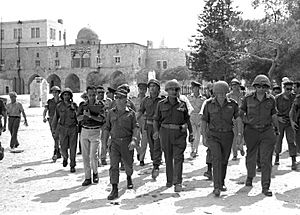
On the morning of June 5, 1967, the Israeli air force launched surprise attacks. They destroyed the Egyptian, Jordanian, and Syrian air forces. Israel then quickly defeated Egypt, Jordan, and Syria. By June 11, the Arab forces were defeated, and all sides accepted a ceasefire.
Israel gained control of the Sinai Peninsula, the Gaza Strip, the Golan Heights, and the West Bank. East Jerusalem was also taken by Israel. Its residents could apply for Israeli citizenship. Other occupied areas remained under military rule.
The Arab League later adopted the Khartoum Resolution. This resolution stated "no peace with Israel, no recognition of Israel, no negotiations with Israel." On November 22, 1967, the UN Security Council passed Resolution 242. This resolution called for peace based on Israel withdrawing from territories occupied in 1967. It also called for all states in the area to respect each other's right to live in peace within secure borders. Both sides accepted the resolution, but with different understandings. It has been the basis for future peace talks.
Late 1960s to Early 1970s
Late 1960s
By the late 1960s, many Jews had left Arab countries like Algeria, Morocco, and Tunisia. About 850,000 Jews from Arab countries moved to Israel, France, and the Americas.
After 1967, most Soviet bloc countries broke off relations with Israel. This led to more Jewish people from the Soviet Union wanting to move to Israel. Many were denied exit visas and faced difficulties.
Because of Israel's victory in the Six-Day War, Jews could visit the Old City of Jerusalem and pray at the Western Wall. This was the holiest site in Judaism. They had not been able to access it since 1949. Other Jewish holy sites, like the Cave of the Patriarchs in Hebron and Rachel's Tomb in Bethlehem, also became accessible. Oil fields in Sinai made Israel self-sufficient in energy.
In 1968, Moshe Levinger led a group of religious Zionists. They created the first Jewish settlement near Hebron, called Kiryat Arba. Also in 1968, compulsory education was extended to age 16. The government started a program to integrate children from different backgrounds in schools.
In March 1968, Israeli forces attacked a Palestinian militia base in Jordan. The Israelis retreated after destroying the camp. The Palestinians claimed victory, and the PLO became well-known in the Arab world.
In early 1969, Prime Minister Levi Eshkol died. Golda Meir became Prime Minister. She was the first female prime minister of Israel and the first woman to lead a Middle Eastern state in modern times.
War of Attrition
In early 1969, fighting broke out between Egypt and Israel along the Suez Canal. Israel responded to Egyptian shelling with air strikes deep into Egypt. This was called the "War of Attrition".
In December 1969, Israeli naval commandos secretly took five missile boats from France. Israel had paid for the boats, but France refused to supply them. In July 1970, Israelis shot down Soviet fighters helping the Egyptians. The US then worked to calm the situation, and a ceasefire was agreed in August 1970.
Early 1970s
In 1971, protests by the Israeli Black Panthers brought attention to discrimination against Mizrahi Jews.
Black September
In September 1970, King Hussein of Jordan forced the Palestine Liberation Organization (PLO) out of his country. The center of PLO activity then moved to Lebanon. An agreement gave Palestinians some control in southern Lebanon. This area became known as "Fatahland" and contributed to the Lebanese Civil War.
Egyptian President Nasser died and was replaced by Anwar Sadat.
Yom Kippur War
In 1972, Egyptian President Anwar Sadat expelled Soviet advisers from Egypt. This, along with frequent military exercises, made Israel feel too confident about the threat from Egypt and Syria. Israel failed to prepare, despite warnings of an attack.
The Yom Kippur War began on October 6, 1973, a Jewish holy day. The Syrian and Egyptian armies launched a surprise attack. At first, Israel struggled to push back the invaders. Both the Soviets and Americans sent arms to their allies.
The Syrians were pushed back on the Golan Heights. Although the Egyptians took some land in Sinai, Israeli forces crossed the Suez Canal. They trapped the Egyptian Third Army in Sinai and advanced close to Cairo. The war cost Israel over 2,000 lives and a lot of money. It made Israelis more aware of their vulnerability. It also increased tension between the US and the Soviet Union.
After the war, both Israelis and Egyptians were more willing to negotiate. In 1974, agreements were reached to separate forces.
The war led to the 1973 oil crisis. Saudi Arabia and other oil-producing countries stopped selling oil to countries that traded with Israel. This caused oil prices to rise sharply. Many countries broke off or reduced relations with Israel. Israel was also banned from Asian sporting events.
After the war, a new political party called Likud was formed. In the December 1973 elections, the Labour party won, and Golda Meir remained prime minister. Likud won 39 seats.
In November 1974, the PLO was given observer status at the UN. Yasser Arafat spoke to the General Assembly. Public anger at the government's lack of preparedness for the war led to Golda Meir's resignation.
Mid to Late 1970s
The Rise of Religious Zionism
In 1974, religious Zionist followers formed the Gush Emunim movement. They began to settle the West Bank and Gaza Strip. In November 1975, the United Nations General Assembly passed a resolution that called Zionism a form of racism. This resolution was later canceled in 1991. In March 1976, Israeli Arabs held a large strike to protest a government plan to take land in the Galilee.
Late 1970s
After Meir resigned, Yitzhak Rabin became prime minister. In July 1976, Rabin ordered Operation Entebbe. This was a mission to rescue Jewish passengers from an Air France flight hijacked by militants and flown to Uganda.
Rabin resigned in April 1977 due to a political issue. Shimon Peres temporarily replaced him.
The Rise of Likud
In a surprising election result, the Likud party, led by Menachem Begin, won in 1977. This was the first time the government was not led by the left-wing party. A key reason for this victory was anger among Mizrahi Jews about discrimination. Begin's government also included Ultra-Orthodox Jews, helping to bridge a gap between them and Zionists.
Begin's economic changes led to very high inflation. However, it also allowed Israel to start receiving financial aid from the US. Begin supported Jewish settlements in the West Bank. This set the stage for future conflicts with Palestinians.
In November 1977, Egyptian President Anwar Sadat made a historic visit to Jerusalem. He was invited by Prime Minister Menachem Begin. Sadat's visit was a turning point. He recognized Israel's right to exist and opened the door for direct talks. After Sadat's visit, a movement called Peace Now was formed to encourage peace.
In March 1978, Lebanese Palestinian militants attacked Israel, killing 38 people, including 13 children. Three days later, Israeli forces entered Lebanon in Operation Litani. Israel later withdrew its troops after the UN called for it.
Camp David Accords
In September 1978, US President Jimmy Carter invited Sadat and Begin to meet at Camp David. They agreed on a plan for peace between Israel and Egypt. This plan also set out ideas for Palestinian self-rule in the West Bank and Gaza. The peace treaty between Egypt and Israel was signed on March 26, 1979. Under the treaty, Israel returned the Sinai Peninsula to Egypt in 1982.
The Arab League reacted by suspending Egypt and moving its headquarters. Sadat was later assassinated in 1981 by Islamic fundamentalists who opposed peace with Israel. After the agreement, Israel and Egypt became the two largest recipients of US military and financial aid.
In December 1978, the Israeli Merkava battle tank began to be used by the IDF. In 1979, more than 40,000 Iranian Jews moved to Israel to escape the Islamic Revolution.
Early to Mid-1980s
On June 30, 1981, the Israeli air force destroyed a nuclear reactor in Iraq. Three weeks later, Begin won the elections again. Ariel Sharon became defense minister. The new government officially added the Golan Heights to Israel. By the 1980s, Israel had developed many high-tech industries.
1982 Lebanon War
After the 1948 war, Israel's border with Lebanon was mostly quiet. But an agreement in 1969 allowed the PLO to attack Israel from southern Lebanon. This area was controlled by the PLO and became known as "Fatahland." Palestinian groups often fired rockets at northern Israeli towns. This lack of control contributed to the Lebanese civil war.
In June 1982, Israel invaded Lebanon. The goal was to push the PLO out of southern Lebanon. The invasion became known as the 1982 Lebanon War. The Israeli army occupied Beirut, which was the first time an Arab capital was occupied by Israel. Some Lebanese people initially welcomed the Israelis. However, resentment against the Israeli occupation grew.
In August 1982, the PLO left Lebanon and moved to Tunisia. The newly elected President of Lebanon was assassinated. One day later, Christian forces massacred Palestinians in refugee camps. This led to the largest anti-war protest ever in Israel. In 1983, an Israeli inquiry found that Defense Minister Sharon was indirectly responsible for the massacres. Israel continued to operate against the PLO and kept a small force in Southern Lebanon until May 2000.
The Mid-1980s
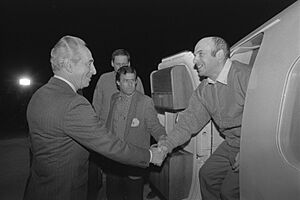
In September 1983, Begin resigned, and Yitzhak Shamir became prime minister. The 1984 election was close, leading to a power-sharing agreement. Shimon Peres was prime minister from 1984 to 1986, and Shamir from 1986 to 1988. In 1984, a new political party called Shas was formed to represent non-Ashkenazi Ultra-Orthodox Jews. It quickly became a major party.
In 1984, during a severe famine in Ethiopia, 8,000 Ethiopian Jews were secretly brought to Israel. By July 1985, Israel had very high inflation. Peres introduced emergency price controls and cut government spending. This successfully brought inflation under control. The currency was also changed. In October 1985, Israel bombed PLO headquarters in Tunisia in response to a terrorist attack. In 1986, Natan Sharansky, a famous Russian human rights activist, was released from prison.
South Lebanon Conflict
In June 1985, Israel partly withdrew from Lebanon. It left a small force and a local militia in southern Lebanon. This was meant to be a "security zone" to protect Israel's northern border. However, this did not end the conflict. The IDF became involved in fighting with Hezbollah, a Shia organization.
Hezbollah became a growing threat to Israel. They often targeted the Galilee region with rockets. The purpose of the security zone seemed unclear. Hezbollah also used psychological warfare, recording their attacks. After a helicopter disaster in 1997, the Israeli public questioned the occupation of southern Lebanon. The Four Mothers movement played a big role in convincing the public to support a full withdrawal, which happened in 2000.
First Intifada
Growing Israeli settlements and the ongoing occupation of the West Bank and Gaza Strip led to the First Intifada in 1987. This uprising was driven by Palestinian frustration after nearly 20 years of military occupation. It began on December 9, 1987.
In the first year, Israeli forces killed 311 Palestinians. Over six years, about 1,162–1,204 Palestinians were killed. Among Israelis, 100 civilians and 60 soldiers were killed. More than 1,400 Israeli civilians and 1,700 soldiers were injured.
This period of protests and riots by Palestinians lasted until the Madrid Conference of 1991. Some say it ended in 1993 with the signing of the Oslo Accords.
Late 1980s to Early 2000s
Late 1980s
In September 1988, Israel launched a reconnaissance satellite into orbit. This made Israel one of only eight countries able to launch satellites independently. The Alignment and Likud parties were very close in the 1988 elections. Shamir formed a national unity government. In March 1990, the Alignment leader tried to form a new government but failed. Shamir became prime minister again.
Gulf War
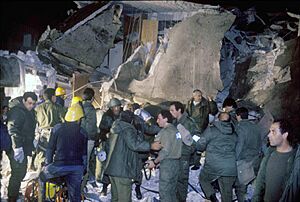
In August 1990, Iraq invaded Kuwait. This started the Gulf War between Iraq and a large allied force led by the United States. Iraq attacked Israel with 39 Scud missiles. Israel did not respond, at the request of the US. The US feared that an Israeli response might cause other Arab nations to leave the allied coalition. Israel provided gas masks to its citizens, and the US deployed Patriot defense systems in Israel.
In May 1991, 15,000 Ethiopian Jews were secretly airlifted to Israel. The victory in the Gulf War opened new possibilities for peace. In October 1991, the US and Soviet Union held a historic meeting in Madrid. Israeli, Lebanese, Jordanian, Syrian, and Palestinian leaders attended. Shamir agreed to participate in return for loan guarantees to help with new immigrants. This led to the collapse of his government.
Soviet authorities finally allowed Jewish people to freely move to Israel. Before this, Jews trying to leave the USSR faced difficulties. Over the next few years, about one million Soviet citizens moved to Israel. This large wave of immigration brought many educated Soviet Jews and created a strong Russian culture in Israel.
Oslo Accords
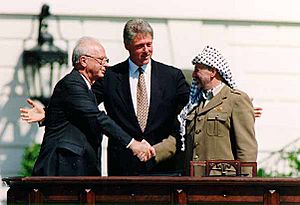
In the 1992 elections, the Labour Party, led by Yitzhak Rabin, won. Rabin promised to pursue peace and not deal with the PLO. Later, the Israeli election system was changed to allow direct election of the prime minister.
On September 13, 1993, Israel and the Palestine Liberation Organization (PLO) signed the Oslo Accords. This agreement set out goals for transferring authority from Israel to an interim Palestinian Authority. This was meant to be a step towards a final treaty establishing a Palestinian state. In return, Israel and the PLO recognized each other.
In February 1994, a follower of the Kach party killed 29 Palestinians in Hebron. The Kach party was later made illegal. Israel and the PLO signed more agreements in 1994. These began the process of transferring authority to the Palestinians. On July 25, 1994, Jordan and Israel signed the Washington Declaration, formally ending their state of war.
Prime Minister Yitzhak Rabin and PLO chairman Yasser Arafat signed the Israeli–Palestinian Interim Agreement on September 28, 1995. This agreement allowed the PLO leadership to move to the occupied territories. It also granted autonomy to the Palestinians. In return, the Palestinians promised to stop using terror and changed their national covenant.
The agreement was opposed by Hamas and other Palestinian groups.
Late 1990s
The May 1996 elections were the first with direct election of the prime minister. Binyamin Netanyahu, leader of Likud, won. Netanyahu continued to implement the Oslo Accords, but the peace process slowed down.
Early 2000s
On May 25, 2000, Israel unilaterally withdrew its remaining forces from southern Lebanon. The UN confirmed that Israel had withdrawn its forces. Lebanon still claims Israel occupies a small area called "Sheba'a Farms." This area gave Hezbollah a reason to continue fighting Israel. The Lebanese government did not take control of the area, and it came under Hezbollah's control.
In the fall of 2000, talks were held at Camp David to reach a final agreement on the Israel/Palestine conflict. Ehud Barak offered to meet most of the Palestinian requests for territory and political concessions. However, Arafat left the talks without making a counterproposal.
After withdrawing from South Lebanon, Israel became a member of the Western European and Others Group at the United Nations. This allowed Israel to participate more fully in UN bodies.
Second Intifada
On September 28, 2000, Israeli opposition leader Ariel Sharon visited the Al-Aqsa compound, also known as Temple Mount. The next day, Palestinians launched the al-Aqsa Intifada. In October 2000, Palestinians destroyed Joseph's Tomb, a Jewish shrine.
The Arrow missile, designed to destroy ballistic missiles, was first used by Israel. In 2001, with the peace process failing, Ehud Barak called a special election for Prime Minister. Ariel Sharon was elected. After this, the system of directly electing the prime minister was stopped.
The failure of the peace process and increased Palestinian attacks led many Israelis to lose confidence in the Palestinian Authority. Many felt that Palestinians saw the peace treaty as temporary. Israelis wanted to separate from the Palestinians. In response to a wave of bomb attacks, Israel launched Operation Defensive Shield in March 2002. Sharon also began building a barrier around the West Bank. Around the same time, the Israeli town of Sderot and other communities near Gaza faced constant rocket and mortar attacks from Gaza.
Thousands of Jews from Latin America began moving to Israel due to economic problems in their home countries. In January 2003, elections were held for the Knesset. Likud won the most seats. A secular party, Shinui, also gained many seats. In 2004, the Black Hebrews were granted permanent residency in Israel.
The Sharon government started building many desalination plants. These plants made Israel free from the fear of drought. Some of Israel's desalination plants are among the largest in the world.
In May 2004, Israel launched a military operation in southern Gaza. This was to create a safer environment for soldiers along the border. In 2005, all Jewish settlers were evacuated from Gaza, some by force. Their homes were demolished. The disengagement from the Gaza Strip was completed on September 12, 2005.
In 2005, Sharon left Likud and formed a new party called Kadima. This party accepted that the peace process would lead to a Palestinian state. Many leaders from both Likud and Labour joined Kadima.
Hamas won the 2006 Palestinian legislative election. Hamas leaders rejected agreements with Israel. They refused to recognize Israel's right to exist and continued to use terror. The withdrawal and Hamas victory left Gaza's status unclear. Israel said it was no longer an occupying power, but still controlled air and sea access. Egypt also refused to open border crossings with Gaza.
In April 2006, Ariel Sharon became ill. Ehud Olmert became Prime Minister.
Late 2000s and 2010s
Late 2000s
In 2005, Mahmoud Ahmadinejad became president of Iran. The conflict between Israel and Iran became more intense. Ehud Olmert was elected Prime Minister after his party, Kadima, won the most seats in the 2006 elections.
On March 14, 2006, Israel carried out an operation in a Palestinian prison in Jericho. The goal was to capture prisoners who had assassinated an Israeli politician. This was because the newly elected Hamas government intended to release them. On June 25, 2006, a Hamas force from Gaza attacked a tank and captured an Israeli soldier, Gilad Shalit. This led to clashes in Gaza.
On July 12, Hezbollah attacked Israel from Lebanon. They shelled Israeli towns and attacked a border patrol. This led to the Second Lebanon War, which lasted through August 2006. Israeli forces entered some villages in Southern Lebanon. The air force attacked targets across the country. The war ended with Hezbollah leaving Southern Lebanon. Israeli troops remained until UN peacekeepers could take over.
In 2007, education became compulsory until age 18. Refugees from Darfur and other illegal immigrants arrived in Israel.
Olmert faced political challenges, which led him to announce his resignation in July 2008. Tzipi Livni won the election for Kadima leader, but could not form a government. Olmert remained in office until the next general election. Israel carried out Operation Cast Lead in the Gaza Strip from December 2008 to January 2009. This was in response to rocket attacks from Hamas militants.
In the 2009 elections, Likud won the most seats. Binyamin Netanyahu formed the government. In 2009, huge natural gas reserves were discovered off the coast of Israel.
Early 2010s
On May 31, 2010, an international incident occurred in the Mediterranean Sea. Foreign activists trying to break the blockade over Gaza clashed with Israeli troops. Nine Turkish activists were killed. In late September 2010, direct talks between Israel and the Palestinians took place but were not successful.
To protect against rocket threats, Israel began using the "Iron Dome" air defense system in March 2011. This system protects southern Israel and the Gaza border.
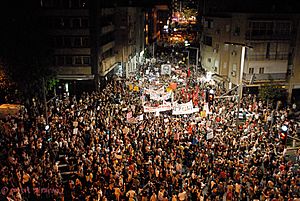
On July 14, 2011, the largest social protest in Israel's history began. Hundreds of thousands of people protested the rising cost of living, especially housing. They also protested the decline of public services. The protests peaked on September 3, 2011, with about 400,000 people demonstrating.
In October 2011, a deal was reached between Israel and Hamas. The kidnapped Israeli soldier Gilad Shalit was released in exchange for 1,027 Palestinian prisoners. In March 2012, Israeli forces carried out a military action in Gaza. This led to five days of clashes along the Gaza border.
In May 2012, Prime Minister Benjamin Netanyahu reached an agreement for Kadima to join the government. However, Kadima left the government in July due to a dispute about military service for Ultra-Orthodox Jews.
In October 2012, the US and Israel began their biggest joint air and missile defense exercise. In response to rocket attacks, Israel began an operation in Gaza on November 14, 2012. This included military actions against Hamas targets. In January 2013, the main section of the barrier on the Israeli-Egyptian border was completed.
Benjamin Netanyahu was elected prime minister again in 2013. He formed a coalition government. In July 2013, Israel agreed to release 104 Palestinian prisoners to restart peace talks. In April 2014, Israel suspended peace talks after Hamas and Fatah agreed to form a unity government.
2014 Gaza War
Following more rocket attacks by Hamas, Israel started an operation in the Gaza Strip on July 8, 2014. This included a ground invasion to destroy cross-border tunnels. Disagreements over the budget and a "Jewish state" bill led to early elections in December 2014. After the 2015 elections, Netanyahu renewed his term as Prime Minister. Likud obtained 30 seats and formed a right-wing coalition government.
Late 2010s
On December 6, 2017, President Donald Trump formally announced that the United States recognized Jerusalem as the capital of Israel. This was followed by the US recognizing the Golan Heights as part of Israel in March 2019. In March 2018, Palestinians in Gaza began weekly protests along the Gaza–Israel border.
2020s–Present
The COVID-19 pandemic began in Israel in February 2020. The government launched a program called Israel Shield to fight the virus. There were lockdowns and mask mandates throughout 2020 and 2021. The vaccination campaign began in December 2020.
In late 2020, Israel normalized relations with four Arab League countries. These were the United Arab Emirates, Bahrain, Sudan, and Morocco. These agreements are known as the Abraham Accords. In May 2021, tensions in Jerusalem escalated. Israel and Hamas exchanged attacks in Gaza for eleven days.
Israel has faced political instability, leading to five elections in four years. Military actions and a rise in Palestinian violence have also led to an increase in conflict.
2023 Israel–Hamas War
Images for kids
See also
 In Spanish: Historia del Estado de Israel para niños
In Spanish: Historia del Estado de Israel para niños


